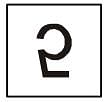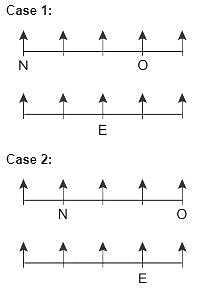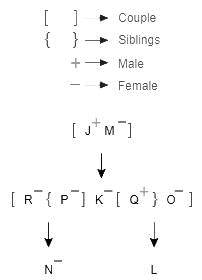Uttarakhand D.El.Ed Mock Test - 4 - UTET MCQ
30 Questions MCQ Test Uttarakhand D.El.Ed Mock Test Series 2024 - Uttarakhand D.El.Ed Mock Test - 4
How does the absence of snow at Mount Fuji impact its ecosystem?
What types of animal species are covered by the SVTGs?
| 1 Crore+ students have signed up on EduRev. Have you? Download the App |
What is the primary purpose of the Indo-Tibetan Border Police (ITBP)?
1. Landslides are mainly caused by human activity and heavy rainfall.
2. Vegetation loss on slopes due to fire or drought increases landslide vulnerability.
3. The Konkan region is prone to landslides.
Which of these statements is/are correct?
What significant event does World Environment Day commemorate?
Identify the alternative which resembles the mirror-image of the given word.
SECRETARY
In the following question, choose the correct mirror-image from amongst the four alternatives (1), (2), (3) and (4) given along with it. The mirror may be represented by a line MN.

Y is to the East of X, which is to the North-East of Z. If P is to the South of Z, then P is in which direction with respect to Y.
Direction: Study the following information and answer the given questions carefully.
A certain number of people live on different floors of a building, where the bottommost floor is numbered 1 and the floor above it is 2 and so on. There is no vacant floor in the building.
J lives three floors above K. One person lives between J and N. The number of persons living between Q and K is equal to the number of persons living between N and S. The number of persons living below H is equal to the number of persons living above S. Q lives three floors above I. The number of persons living between I and N is one less than the number of persons living below J. K lives on the 5th floor. S doesn’t live on a perfect square-numbered floor. One person lives between I and H. One person lives between Q and J.
Q. Who among the following one lives on the bottommost floor?
Direction: Study the following information and answer the given questions carefully.
Ten people are sitting in two parallel rows such that people sitting in row 2 are just behind people in row 1. In row 1 - M, N, O, P and Q are sitting and all are facing north. In row 2 - A, B, C, D and E are sitting and all are facing north.
One who sits just behind O is to the immediate right of E. O sits 3rd to the right of N. B is neither at any of the extreme ends nor sits exactly behind O. P sits on a seat which is exactly ahead of A. D doesn’t sit at any of the extreme ends. M is not exactly ahead of E. Number of people sitting between C and E, is the same as the number of people sitting between E and B.
Q. If P exchanges its position with O, then who sits exactly behind of O?
Directions to Solve
In each of the following questions two statements are given and these statements are followed by two conclusions numbered (1) and (2). You have to take the given two statements to be true even if they seem to be at variance from commonly known facts. Read the conclusions and then decide which of the given conclusions logically follows from the two given statements, disregarding commonly known facts.
Give answer:
- (A) If only (1) conclusion follows
- (B) If only (2) conclusion follows
- (C) If either (1) or (2) follows
- (D) If neither (1) nor (2) follows and
- (E) If both (1) and (2) follow.
Question -
Statements: All cars are cats. All fans are cats.
Conclusions:
- All cars are fans.
- Some fans are cars.
Direction: Read the following information carefully and answer the questions given below :
Relations of a family consisting of J, K, L, M, N, O, P, Q, and R are given in a coded language using symbols. Study the following information and answer the questions given below.
P @ Q means P is father of Q
P # Q means P is mother of a Q
P $ Q means P is brother of a Q
P © Q means P is sister of a Q
P % Q means P is son of Q
P * Q means P is daughter of Q
J @ P * M, P © K © Q @ L, P # N % R, Q $ K, O # L
How is L related to K?
Direction: Read the following information carefully and answer the questions that follow.
Sunita is taller than Seeema and Renu, Renu is shorter than Radha and Gauri. Bina is taller than Radha and shorter than Sunita. Sunita is not the tallest and Renu is not the shortest.
Q. What is the position of Radha from the shorter end?
In this following questions, various terms of the letter series are given with one term missing as shown by (?). Choose the missing term out of the given alternative.
CE, GI, KM, OQ,?
If second half of the following alphabet is written in reverse order then which letter will be 10th from left of 9th letter from the right end?
A B C D E F G H I J K L M N O P Q R S T U V W X Y Z
Two players A and B are playing a game of putting ‘+’ and '-'signs in between any two integers written from 1 to 100. A starts the game by putting a plus sign anywhere between any two integers. Once all the signs have been put, the result is calculated. If it is even then A wins and if it is odd then B wins, provided they are putting signs by taking turns one by one and either of them can put any sign anywhere between any two integers. Who will win at the end?
It takes eight hours for a 600 km journey, if 120 km is done by train and the rest by car. It takes 20 minutes more, if 200 km is done by train and the rest by car. What is the ratio of the speed of the train to that of the car?
By selling bouquets for ₹ 69, a florist gains 15%. At what price should he sell the bouquets to gain 20%on the cost price?
In a right angled triangle, find the hypotenuse if base and perpendicular are respectively 36015 cm and 48020 cm.
John and Dani go for an interview for two vacancies. The probability for the selection of John is 1/3 and whereas the probability for the selection of Dani is 1/5. What is the probability that none of them are selected?
Out of all the 2 - digit integers between 1 to 200, a 2-digit number has to be selected at random. What is the probability that the selected number is not divisible by 7?
Which of the following is the correct meaning of diversity?
Which of the following statement is correct regarding the school management committee and Executive committee?
Audio-visual teaching aid among the following is :
Which of the following is not an activity aids related to teaching-learning materials?




























